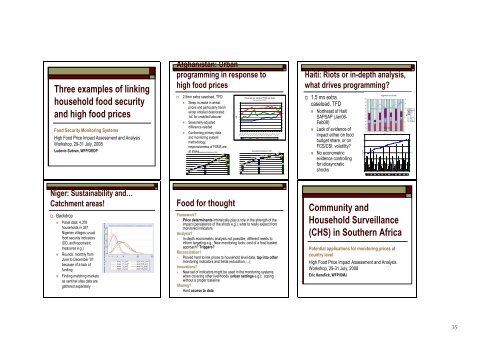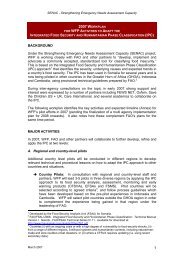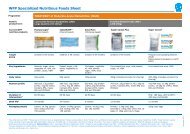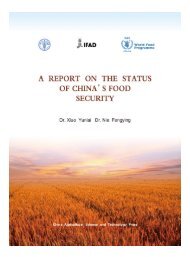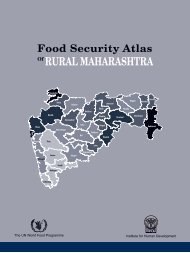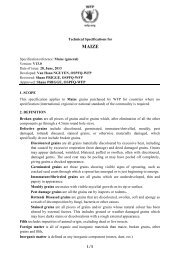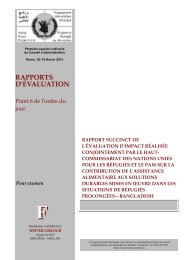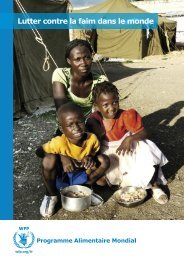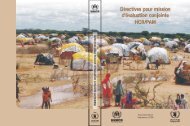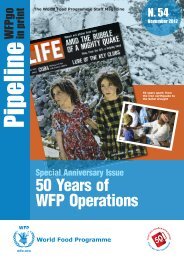High Food Price Impact Assessment and Analysis - WFP Remote ...
High Food Price Impact Assessment and Analysis - WFP Remote ...
High Food Price Impact Assessment and Analysis - WFP Remote ...
Create successful ePaper yourself
Turn your PDF publications into a flip-book with our unique Google optimized e-Paper software.
Bread<br />
Cereals<br />
Roots<br />
Dairy<br />
Pulses<br />
Meat & Eggs<br />
Other <strong>Food</strong><br />
Oil <strong>and</strong> Fat<br />
Veg. & Fruits<br />
Sugar<br />
<strong>Food</strong><br />
Transport<br />
Tobacco<br />
Soap<br />
Taxes<br />
Debts<br />
Medical<br />
Celebrations<br />
Education<br />
Non <strong>Food</strong><br />
Other Non <strong>Food</strong><br />
House<br />
Clothing<br />
Total<br />
Cereals<br />
Roots<br />
Bread<br />
Dairy<br />
Pulses<br />
Meat & Eggs<br />
Oil <strong>and</strong> Fat<br />
Ve g. & F ruits<br />
Other <strong>Food</strong><br />
Sugar<br />
<strong>Food</strong><br />
Transport<br />
Tobacco<br />
Soap<br />
Taxes<br />
Clothing<br />
House<br />
Medical Debts<br />
Non <strong>Food</strong><br />
Celebrations<br />
Education<br />
Other Non F ood<br />
Total<br />
300<br />
250<br />
200<br />
150<br />
100<br />
50<br />
0<br />
Rounds<br />
1 2 3 4 5 6 7<br />
1 2 3 4 5 6 7<br />
Riz Maize Wheat Bread Sugar Milk Noodles Oil Potato Banana Chicken FCS<br />
120<br />
100<br />
80<br />
60<br />
40<br />
20<br />
0<br />
Three examples of linking<br />
household food security<br />
<strong>and</strong> high food prices<br />
<strong>Food</strong> Security Monitoring Systems<br />
<strong>High</strong> <strong>Food</strong> <strong>Price</strong> <strong>Impact</strong> <strong>Assessment</strong> <strong>and</strong> <strong>Analysis</strong><br />
Workshop, 29-31 July, 2008<br />
Ludovic Subran, <strong>WFP</strong>/OEDP<br />
Afghanistan: Urban<br />
programming in response to<br />
high food prices<br />
<br />
2.5mn extra caseload, TFD<br />
• Steep increase in wheat<br />
prices <strong>and</strong> particularly harsh<br />
winter entailed deteriorated<br />
‘tot’ for unskilled labourer<br />
• Seasonally-adjusted<br />
difference needed<br />
• Confronting primary data<br />
<strong>and</strong> monitoring system:<br />
methodology,<br />
responsiveness of FSMS are<br />
at stakeExpenditures Breakdown in 2006<br />
Afs<br />
50<br />
45<br />
40<br />
35<br />
30<br />
25<br />
20<br />
15<br />
10<br />
5<br />
0<br />
<strong>Price</strong>s are up, Terms of Trade are down<br />
Kabul Retail <strong>Price</strong>s, <strong>WFP</strong>/AFG<br />
Jan-05<br />
Mar-05<br />
May-05<br />
Jul-05<br />
Sep-05<br />
Nov-05<br />
Jan-06<br />
Mar-06<br />
May-06<br />
Jul-06<br />
Sep-06<br />
Nov-06<br />
Jan-07<br />
Mar-07<br />
May-07<br />
Jul-07<br />
Sep-07<br />
Nov-07<br />
Bread (1kg) Fuel (1L) ToT Casual Labour/Wheat Flour (Right axis)<br />
Expenditures Breakdown in 2007<br />
16<br />
14<br />
12<br />
10<br />
8<br />
6<br />
4<br />
2<br />
0<br />
Haiti: Riots or in-depth analysis,<br />
what drives programming?<br />
<br />
1.5 mn extra<br />
caseload, TFD<br />
• Northeast of Haiti<br />
SAPSAP (Jan06-<br />
Feb08)<br />
• Lack of evidence of<br />
impact either on food<br />
budget share, or on<br />
FCS/CSI: volatility?<br />
• No econometric<br />
evidence controlling<br />
for idiosyncratic<br />
shocks<br />
Prix (gourdes)<br />
Grisom Garde<br />
FCS<br />
Niger: Sustainability <strong>and</strong>…<br />
Catchment areas!<br />
<br />
Backdrop<br />
• Panel data: 4,376<br />
households in 357<br />
Nigerien villages; usual<br />
food security indicators<br />
(DD, anthropometric<br />
measures e.g.)<br />
• Rounds: monthly from<br />
June to December ’07<br />
because of a lack of<br />
funding<br />
• Finding matching markets<br />
as sentinel sites data are<br />
gathered separately<br />
<strong>Food</strong> for thought<br />
Framework?<br />
• <strong>Price</strong> determinants intrinsically play a role in the strength of the<br />
impact (persistence of the shock e.g.), what to really expect from<br />
monitored indicators<br />
<strong>Analysis</strong>?<br />
• In-depth econometric analysis not possible; different needs to<br />
inform targeting e.g.; New monitoring tools: cost of a food basket<br />
approach? Triggers?<br />
Reconciliation?<br />
• Proved hard to link prices to household level data, tap into other<br />
monitoring indicators <strong>and</strong> fields (education,…)<br />
Innovations?<br />
• New set of indicators might be used in the monitoring systems<br />
when covering other livelihoods (urban settings e.g.); coping<br />
without a proper baseline<br />
Sharing?<br />
• Hard access to data<br />
Community <strong>and</strong><br />
Household Surveillance<br />
(CHS) in Southern Africa<br />
Potential applications for monitoring prices at<br />
country level<br />
<strong>High</strong> <strong>Food</strong> <strong>Price</strong> <strong>Impact</strong> <strong>Assessment</strong> <strong>and</strong> <strong>Analysis</strong><br />
Workshop, 29-31 July, 2008<br />
Eric Kenefick, <strong>WFP</strong>/OMJ<br />
35


